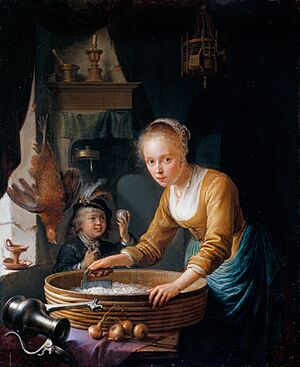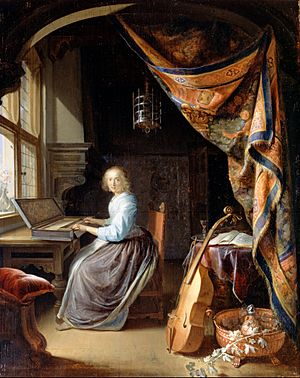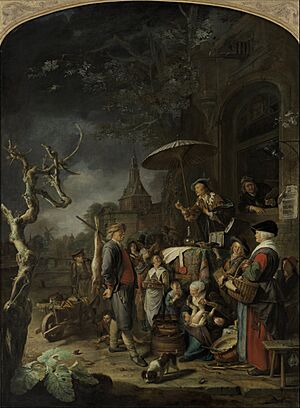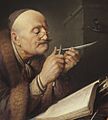Gerrit Dou facts for kids
Quick facts for kids
Gerrit Dou
|
|
|---|---|
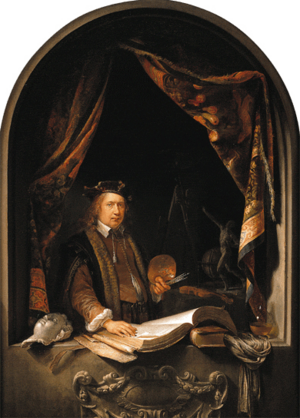
Self-portrait (c. 1665), Museum of Fine Arts, Boston
|
|
| Born | 7 April 1613 |
| Died | 9 February 1673 (aged 61) |
| Nationality | Dutch |
| Education | Rembrandt (master) |
| Movement | Leiden fijnschilder |
Gerrit Dou (born April 7, 1613 – died February 9, 1673) was a famous Dutch Golden Age painter. He was also known as Gerard Douw or Dow. His small, very detailed paintings are typical of the Leiden fijnschilders, a group of artists from Leiden known for their precise work.
Dou was especially good at painting genre scenes, which are pictures of everyday life. He was also known for his trompe-l'œil "niche" paintings, which trick your eye into thinking they are real objects. He also painted amazing night scenes lit by candles, using strong contrasts between light and dark, called chiaroscuro. Gerrit Dou was a student of the famous painter Rembrandt.
Contents
Early Life and Training
Gerrit Dou was born in Leiden, a city in the Dutch Republic. His father made stained-glass windows. Gerrit first learned drawing from Bartholomeus Dolendo. After that, he worked in Pieter Couwenhorn's stained-glass workshop.
When he was 14, in February 1628, his father sent him to study painting. He became a student of the famous artist Rembrandt, who was about 21 years old at the time. Rembrandt lived nearby. Dou stayed with Rembrandt for about three years. From Rembrandt, he learned how to use colors well and how to create subtle light and dark effects. You can see Rembrandt's influence in some of Dou's early paintings. One example is a self-portrait he painted when he was 22.
Dou's Unique Painting Style
Even though he learned from Rembrandt, Gerrit Dou soon developed his own special style. He became known for his extremely detailed and careful way of painting. People say he sometimes spent five days just painting one hand! His work was so fine that he had to make his own tiny brushes.
Despite all the tiny details, his paintings looked smooth and natural. His colors were always bright and clear. He often painted scenes lit by lanterns or candles. He was incredibly skilled at showing these light effects. To get everything just right, he sometimes used a special lens and looked through a frame with silk threads to help him see details.
Dou started out painting many portraits. But over time, he painted fewer because people didn't want to sit still for as long as he needed. His paintings were always small. Today, more than 200 of his works are known. You can find them in many major art museums across Europe.
Famous Works and Success
Some of Gerrit Dou's most famous paintings include The Dropsical Woman (1663) and The Dutch Housewife (1650), both found in the Louvre museum in Paris. The Evening School, at the Amsterdam Rijksmuseum, is a great example of his amazing candlelit scenes. The National Gallery, London has good examples like Poulterer's Shop (1672) and a self-portrait.
Dou's paintings were very expensive. One important art collector, Pieter Spiering, paid Dou 500 guilders every year. This payment was just so Spiering could have the first chance to buy Dou's newest paintings. Queen Christina of Sweden owned eleven of Dou's paintings. Cosimo III de' Medici, a powerful Italian ruler, even visited Dou's home and bought at least one painting that is now in the Uffizi Gallery.
Later Life and Legacy
Gerrit Dou died in Leiden. He taught many students who became famous artists themselves. His most well-known students were Frans van Mieris the Elder and Gabriël Metsu. He also taught other painters like Godfried Schalcken and Pieter Cornelisz van Slingelandt.
Posthumous Reputation
For a long time after his death, Gerrit Dou's paintings continued to sell for very high prices. This lasted until the 1860s. After that, he became almost forgotten by the art world. For example, when the Metropolitan Museum of Art had a big exhibit of Dutch art, they showed many paintings by Rembrandt and Hals, but none by Dou. He remained largely unknown until the 1970s. Since then, his reputation has grown again, and he is now recognized as an important artist.
Selected Works
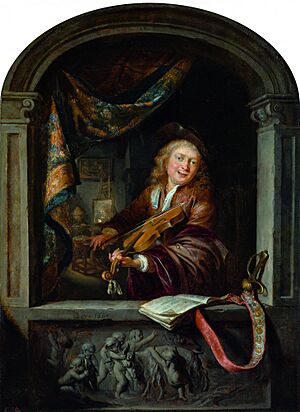
- The Night School (Rijksmuseum, Amsterdam)
- 1628: Astronomer (Hermitage Museum, Saint Petersburg)
- 1631-1632: Old Woman Reading (Rijksmuseum, Amsterdam)
- 1630s: Portrait of a Girl (Manchester Art Gallery, UK)
- 1631: Prince Rupert (J. Paul Getty Museum, Los Angeles)
- 1635–1636: Still Life with a Boy Blowing Soap-Bubbles (National Museum of Western Art, Tokyo)
- 1635–1640: Portrait of a Man (National Gallery, London)
- 1637: An Interior with a Young Violinist (National Galleries of Scotland)
- 1640s: Portrait of a Young Woman (National Gallery, London)
- 1640–1645: Portrait of a Man (Hermitage Museum, Saint Petersburg)
- 1642–1647: St. Jerome in the Desert (Memorial Art Gallery of the University of Rochester, New York)
- 1645: The Schoolmaster (Fitzwilliam Museum, Cambridge)
- 1646: Girl Chopping Onions (Royal Collection, London)
- 1647: Still Life With Book and Purse (J. Paul Getty Museum, Los Angeles)
- 1650: The Dutch Housewife (Louvre, Paris)
- 1650s: The Young Mother (Gemäldegalerie, Berlin)
- 1650s: Self Portrait (Rijksmuseum, Amsterdam)
- 1650s: Self-portrait at the Window (Residenzgalerie, Salzburg)
- 1658-1665: Young Woman with a Lighted Candle at a Window (Thyssen-Bornemisza Museum, Madrid)
- 1652: The Quack Doctor (Museum Boymans-van Beuningen, Rotterdam)
- 1653:The Physician (Christchurch Art Gallery Te Puna o Waiwhetu, Christchurch, New Zealand)
- 1653: The Violin Player (Liechtenstein Palace, Vienna)
- 1655: Old Woman Cutting Bread (Museum of Fine Arts, Boston)
- 1655: Astronomer by Candlelight (J. Paul Getty Museum, Los Angeles)
- 1658: The Young Mother (Mauritshuis, The Hague)
- 1660s: The Nursery (Lost with the sinking of the Vrouw Maria in 1771)
- 1660–1665: Dentist by Candlelight (Kimbell Art Museum, Fort Worth)
- 1660–1665: Old Woman Unreeling Threads (Hermitage Museum, Saint Petersburg)
- 1660–1665: Soldier Bather (Hermitage Museum, Saint Petersburg)
- 1660-1665: Woman Bather (Hermitage Museum, Saint Petersburg)
- 1660-1665: Self-portrait (Louvre, Paris)
- 1661: A Hermit (Wallace Collection, London)
- 1663: The Dropsical Woman (Louvre, Paris)
- 1663: Woman at a Window with a Copper Bowl of Apples and a Cock Pheasant (Fitzwilliam Museum, Cambridge)
- 1665: A Lady playing a Clavichord (Dulwich Picture Gallery, London)
- 1670: A Hermit Praying (Minneapolis Institute of Arts, Minnesota)
- 1670: The Hermit (National Gallery of Art, Washington, D.C.)
- 1670s: A Poulterer's Shop (National Gallery, London)
- 1670–75: The Herring Seller (Hermitage Museum, Saint Petersburg)
- Self Portrait (National Gallery, London)
- Portrait of a Young Man (Fitzwilliam Museum, Cambridge)
- Evening Light (Rijksmuseum, Amsterdam)
- Young Man (The Hague)
- The Cook (Louvre, Paris)
- The Spinner (Gala-Salvador Dalí Foundation)
- The Spinning Reel (Fine Arts Museums of San Francisco)
- The Reader (Fine Arts Museums of San Francisco)
- Portrait of an Unknown Gentleman (Museum of Fine Arts at the University of Montana, Missoula)
- Dog at Rest (Museum of Fine Arts, Boston)
Images for kids
-
Self-portrait, 1635–1638, Cheltenham Art Gallery and Museum
-
Self-portrait, c. 1650, Rijksmuseum Amsterdam
-
Reading the Bible, c. 1645, Louvre
-
The Grocer's Shop, 1647, Louvre
-
Dutch Housewife, 1650, Louvre
-
The Physician, 1653, Kunsthistorisches Museum, Vienna
-
A Hermit, 1664, Rijksmuseum
-
Old Woman Cutting Bread, c. 1655, Museum of Fine Arts, Boston
-
The Silver Ewer c. 1663, Louvre
-
The Moneylender, c. 1664, Louvre
-
Woman Pouring Water into a Jar, from 1655 until 1665, Louvre
See also
 In Spanish: Gerrit Dou para niños
In Spanish: Gerrit Dou para niños


